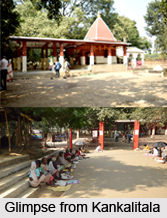 Kankalitala Temple is a sacred spot of Hindu community, who belongs from the Shakta sects, located in Bolpur on the Bolpur-Labhpur road that is situated at the banks of Kopai River.
Kankalitala Temple is a sacred spot of Hindu community, who belongs from the Shakta sects, located in Bolpur on the Bolpur-Labhpur road that is situated at the banks of Kopai River.
Location of Kankalitala Temple
Kankalitala Temple is a temple located in Bolpur subdivision on the roadway to Bolpur- Murshidabad District connector. Kankalitala Temple is one of the fifty-one Shakti Peethas on the banks of Kopai River.
Mythology of Kankalitala Temple
Kankalitala Temple is located about 10 km from Shantiniketan. According to Hindu mythology, when the dead body of Parvati was cut by Lord Vishnu`s Sudarshan chakra, the waist fell at Kankalitala. There are several temples that adorn the town and its adjacent area.
Visiting Kankalitala Temple
The Kankalitala mela near Kankalitala Temple held every year in the month of April on the last day of Chaitra month is observed the natural beauty and religious sacredness that attracts so many visitors throughout that it has almost earned the popularity of a picnic spot. The temple is located in the middle of agricultural fields and the river Kopai flows behind the temple. The area is desolate and very few people venture there at night. Near Kankalitala Temple, there is a small burial ground that adds desolation.
Architecture of Kankalitala Temple
The sanctum of Kankalitala Temple is a simplistic square sanctuary capped by a pyramidal roof which is further topped by a metallic spire shaped like ceremonial pots of gradually decreasing sizes placed atop each other. The natmandir of Kankalitala Temple, where visitors and devotees sit and pray from is three bays wide and four bays long. Unlike other Shakti Peethas, here Goddess Sati"s organ are not reverentially placed in the sanctum but are said to be submerged in a square tank which is located close to the central temple and lead to by a flight of stairs on each side. On the other side of the Kankalitala Temple, there is a sacred tree on which are hung numerous marigold wreaths and rounded stones tied with threads. Kankalitala Temple is actually very large. But there are not many permanent structures within the campus. There are the Shiva temple, lined with marble and adorned with vermilion motifs, which is located a couple of hundred meters away, close to the entrance gateway of Kankalitala Temple.



















